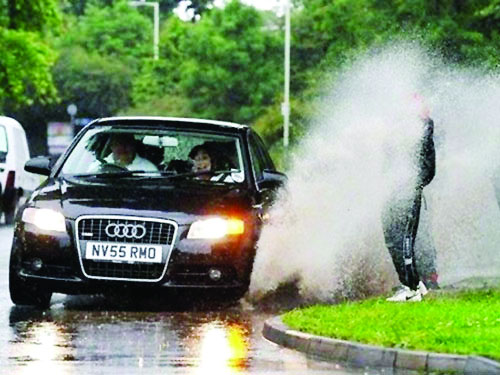A recent run down north Indian highways proved to me that road quality improvements still have a way to go
Driving in India during the monsoon is a wonderful experience, at least when it comes to the view, the skies being heavy with moisture and the entire countryside in various shades of green. Yet, there are some problems, not least of which are the slightly troubling driving habits of fellow countrymen on the roads. For one, even under poor visibility in heavy rain, far too many folks do not drive with their headlights on. The fact is, under really heavy rain, many people have their vehicles in poor conditions and India's driving 'tests' barely prepare most drivers for such challenging conditions.
The new amendments to the Motor Vehicles Act that are under consideration in Parliament, for far too long in my opinion do not just have a focus on safety but unfortunately omit some minimum educational qualifications for drivers. As everyone is aware, the chaos of India makes driving a challenge on both city roads and highways, not least because the differing speeds of the vehicles on the roads is a challenge. The car I was driving this past weekend was the Audi A4 35TDI, a powerful vehicles with 190 horsepower, excellent handling and very good brakes. But I was sharing the highways, with bullock carts and tractors. While I understand that the roads are meant for everyone, there has to be better traffic management.
However, enforcement agencies do not impose proper traffic management on Indian roads. For example, many heavy commercial vehicles travel on the right-hand lane, and there is a peculiar cause for this, as trees that have not been pruned on the roadside actually cause an impediment for tractor trailers carrying large containers or car carriers. Also, Indian roads have differing speed limits for different classes of vehicles, but this means that traffic signs, particularly for speed do not conform to international norms and are often unreadable.
There is another topic that I would like to touch upon, during this drive that is the road surface. The Delhi-Chandigarh highway, NH-1 till Ambala and NH-22 from Ambala onwards has been in a perpetual state of work as far as I can remember. While the excellent Panipat and Karnal bypasses have dramatically cut time, work on the Delhi-Panipat stretch has caused jams in and around Sonipat. But this work is important and I am hoping that the road surface on this new stretch is made in concrete rather than asphalt.
let me explain why, throughout the drive on a level plain surface while I was driving straight ahead the traction control system of the Audi I was driving engaged. While the rain was heavy, there was no reason for this to happen, or so I thought but then I began to notice the undulating surface of the road. What had clearly happened is that over the months of May and June, when the outside temperature in northern India close to 50 degrees and the road surface temperature often exceeding 75-80 degrees, the top layer of asphalt had clearly been tempered like chocolate, that is it had melted and reformed. Roads have a friction index or rolling resistance, basically a measure of how much grip there is on the road surface. Clearly, the 'tempered' asphalt had lost its resistance and the tyres were struggling for grip. This A4 was not equipped with Audi's Quattro system, and an all-wheel drive system would have quite nice under these circumstances. Braking, even with the great brakes on the car can best be described as a bit patchy, and this is not to fault the car, but the undulating and slippery surface. At times it genuinely felt like I was driving on a smooth granite surface. At least one prominent five-star hotel in India has patches of granite at its porch and from experience I can assure you, grip is non-existent.
There have been many debates on what surface to use on roads, but concrete roads while more expensive have always had far superior grip even in wet conditions. The fact is that our highways and expressways need far superior traffic management because most people who drive on these roads have little or no training for high-speed traffic. And that applies even to people who can afford cars like the brilliant and economical Audi A4 I drove, while the electronics of the car worked overtime to ensure that the car kept on going smoothly, I also followed the speed limits. Just because you can afford a car that can go fast does not mean you should drive like a hoon. Indeed, even a smooth road can have a poor surface particularly when wet which can compromise braking and one should always be careful how they drive in the rain.


























